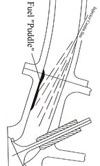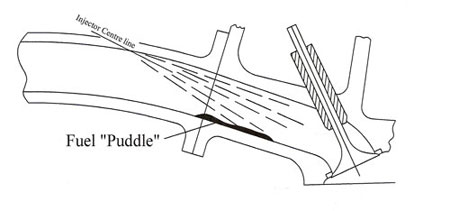Wall wetting - the 'Tau' factor
 In a conventional multi-point port injected gasoline engine the fuel is introduced into the air stream in the form of a jet of liquid. Atomising into small droplets, these mix with the air, begin to vaporise and eventually get carried off past the intake valves and into the combustion chamber. In between, varying amounts of this fuel might condense on the wall, travel along it and eventually vaporise back into the air stream. However the presence of this fuel, often referred to as a 'puddle' can have a significant effect on the air fuel ratio eventually presented to the engine. In most road transport applications with port injection, the injector is most likely targeted at the back of the intake valve. Here it is assumed that the fuel jet strikes the back of the valve missing as much of the manifold as possible and is vaporised straight into the engine. Good hydrocarbon emissions and best fuel economy result. While many racing engines use a similar method others prefer to inject fuel into the centre of the bellmouth at the entrance to the intake runner. While the former might have a relatively low amount of fuel to 'puddle', the latter with its potentially large surface area of wall to wet could introduce significant transient fuelling issues. However no fuel injector can ever inject 100% of its fuel into the air stream and therefore to compensate for this effect on all engines and more accurately control the engine under transient engine conditions, it is necessary to predict this volume of fuel temporarily sidelined.
In a conventional multi-point port injected gasoline engine the fuel is introduced into the air stream in the form of a jet of liquid. Atomising into small droplets, these mix with the air, begin to vaporise and eventually get carried off past the intake valves and into the combustion chamber. In between, varying amounts of this fuel might condense on the wall, travel along it and eventually vaporise back into the air stream. However the presence of this fuel, often referred to as a 'puddle' can have a significant effect on the air fuel ratio eventually presented to the engine. In most road transport applications with port injection, the injector is most likely targeted at the back of the intake valve. Here it is assumed that the fuel jet strikes the back of the valve missing as much of the manifold as possible and is vaporised straight into the engine. Good hydrocarbon emissions and best fuel economy result. While many racing engines use a similar method others prefer to inject fuel into the centre of the bellmouth at the entrance to the intake runner. While the former might have a relatively low amount of fuel to 'puddle', the latter with its potentially large surface area of wall to wet could introduce significant transient fuelling issues. However no fuel injector can ever inject 100% of its fuel into the air stream and therefore to compensate for this effect on all engines and more accurately control the engine under transient engine conditions, it is necessary to predict this volume of fuel temporarily sidelined.
The volume of the fuel trapped on the manifold wall is often known as Tau and designated by the Greek letter '?'. In modelling it is assumed that the amount of the 'puddle' or fuel volume remains constant and the air flowing over it carries it away towards the engine. The more the volume of air flowing past or over it, the more the mass of the puddle is reduced. Tau modelling software therefore uses instantaneous airflow calculations to attempt to predict and maintain this value constant by either adding or reducing to the fuel specified in the engine map.

Under steady state running the engine will be calibrated to run at optimum air-fuel ratio, be that slightly rich for maximum power or slightly weak for best fuel economy. During rapid changes, for example when the throttle is suddenly snapped open and the wall film rapidly evaporates, is when compensation is necessary. If this isn't done the engine will 'see' a temporary lean spike resulting in a hesitation or a loss of power followed by a sudden surge back to where it would have been. Likewise when the driver lifts off the throttle at high engine speeds and no power is demanded, fuel may need to be temporarily switched off but to make sure that the fuel 'puddle' is maintained and that a lean spike won't result as soon as the throttle is opened again, a degree of fuel may have to be re-introduced
On more complex systems, the intake models to predict and consequently control the air-fuel ratio more accurately, have to be much more sophisticated. Intake manifold volume, port design and even the positioning of the sensors used, all have to be taken into account to anticipate the airflow to each of the cylinders and during each and every cycle, if perfect engine control is to be achieved.
Fig. 1 - The 'Tau' factor.
Written by John Coxon